How to grow ginger at home on a windowsill
Ginger is a tropical herb that is widely used in cooking and medicine.
Is it possible to grow a wonderful plant at home? Yes, you can.
Gardeners and "indoor gardeners" who love everything, so to speak, homemade, have long been growing ginger root in indoor conditions. You just need to know all the nuances of planting and care, then it will not be difficult to grow ginger at home on the windowsill.
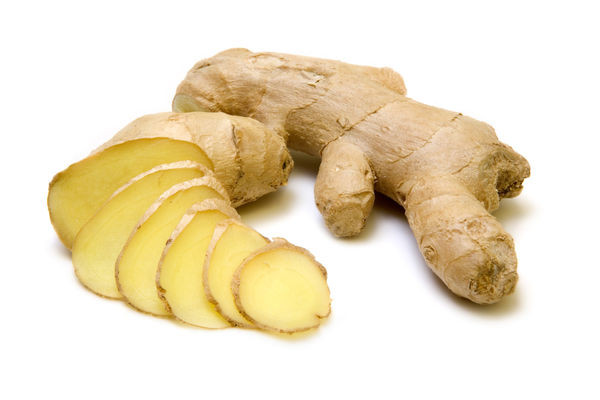
Content
- 1 Features of growing ginger on a windowsill
- 2 When to plant ginger at home
- 3 What ginger is suitable for growing on a windowsill
- 4 How to plant ginger on a windowsill - features, conditions and step-by-step instructions
- 5 How to care for ginger on a windowsill
- 6 Problems of growing ginger in an apartment: diseases and pests
- 7 Terms of germination and harvesting of ginger on the windowsill
Features of growing ginger on a windowsill
Ginger on the windowsill is grown not only for spicy and healthy roots, but also as an ornamental plant (if you like reeds).
Interesting! During the flowering period, a beautiful lilac flower appears on an unsightly plant. However, it will take a long time to wait for flowering, about 3 years, and it is not a fact that it will bloom in indoor conditions ...
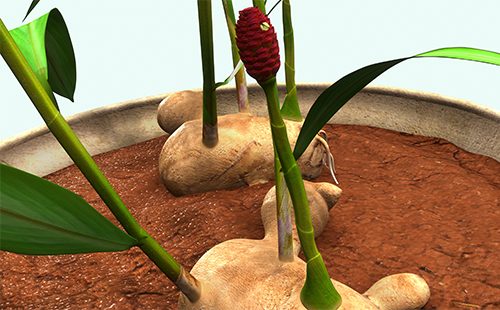
The spice came to our area from hot and humid tropical forests. In order for the plant to be comfortable, and in general, the cultivation of ginger on the windowsill was successful, it is necessary to create a microclimate in the room similar to the natural one.
Be sure to watch the next video, in which the author talks in detail about the mistakes that can be easily made when planting ginger in a pot.
Video: how to grow ginger + health benefits of ginger root (against which diseases it helps)
When to plant ginger at home
Worth knowing! Ginger rhizomes mature within 8-10 months. Therefore, in order to get a harvest by autumn (in October-November), and for the winter the plant could normally retire, it is optimal to plant ginger in late winter - February or early spring (in March). During this period, daylight hours are just beginning to lengthen, which means that you will have less additional lighting at the initial stage.
However, this does not mean at all that you cannot plant at another time, you just have to artificially create suitable conditions.
What ginger is suitable for growing on a windowsill
Naturally, in order to plant a plant, you first need to buy planting material somewhere. It is quite simple to do this, you will need ginger root, which is sold in the supermarket, so to speak, "for consumption." It is difficult, if not impossible, to find planting ginger in garden stores.
Of course, the planting material must meet certain requirements:
- the root should be dense and elastic;
- without any damage and disease (especially decay);
- optimal dimensions - at least 5-8 cm in length, 3-4 cm in width;
- the most important thing is to have points of growth at the root (at least 1, but in general, the more the better).
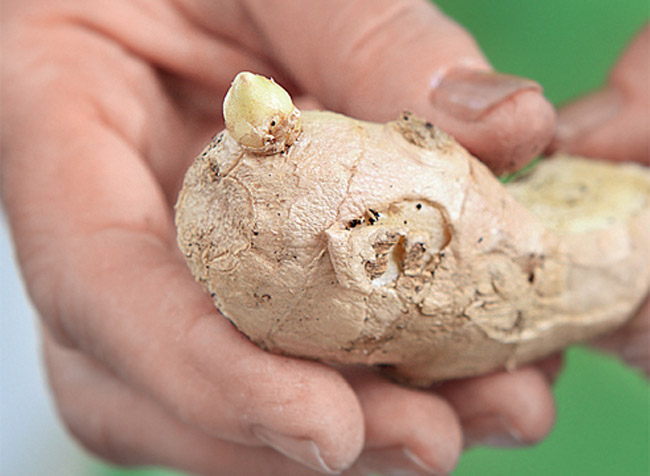
How to plant ginger on a windowsill - features, conditions and step-by-step instructions
Before directly planting the ginger root, you should choose the most suitable container for growing, as well as the soil.
What container to plant
It is very important for ginger to choose a suitable planting container, because it grows quite strongly. Since the ginger root does not grow in depth, but in width, thenfor planting, it is better to stop at a shallow (we can say that flat) wide plastic container of medium size.
However, in nature (outdoors), ginger builds up a fairly deep root system, so if you plant it not only in a wide, but in a deep pot, then there will be a chance to get an even larger yield.
Too small pots (especially ceramic ones) should not be taken, they can simply be torn apart.
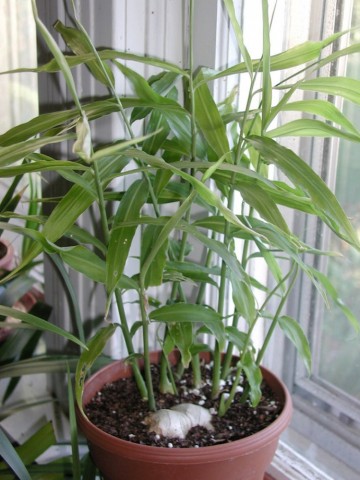
In no case should moisture stagnate in the pot, which means that not only moisture and breathable soil is required, but also drainage. In other words, it is necessary that all excess water after watering flows into the sump, there should be drainage holes in the bottom of the pot... In addition, at the bottom of the planting container should be laid out expanded clay layer (or similar material) 3-5 cm thick.
What soil (substrate) to plant
Ginger loves loose and fertile soil, while it should be slightly acidic in reaction.
Therefore, almost any ready-made peat-based substrate will work for you, except that it should be loosened by adding sand.
For self-preparation, you can take: 1 part of sod land, 1 part of humus or compost, as well as 1/2 river sand or vermiculite (perlite).
Advice! Any, even purchased land, is recommended to be disinfected (in order to destroy all pathogenic flora) by spilling a solution of potassium permanganate or phytosporin. Alternatively, you can steam it in the oven.
Pre-landing preparation
The acquired ginger root for planting at home is prepared as follows:
- The roots are immersed in warm water (room temperature or slightly warmer) for 2-5 hours. During this time, the dormant buds should awaken.
By the way! If desired, and for complete confidence, then you can hold the root for 20-30 minutes in a solution of potassium permanganate. Or add potassium permanganate to the water.
- Further, if you have a rather massive root, then it can be divided into parts (5-8 centimeters in length, 3-4 in width), so that each part has one living bud (at least), and preferably several buds.
However! Better to plant large roots. If you divide the tuber, then it grows much weaker.
- Then you should lightly dry the roots so that the slices dry. They can also be treated with charcoal to ensure they don't rot. And you can sprinkle with crushed activated carbon (sold in any pharmacy).
As soon as the planting material dries up, you can start planting ginger in the ground.
Direct landing
Step-by-step instructions for planting ginger root for growing on a windowsill at home:
- Prepare planting containers.
- Pour a drainage layer on it with soil.
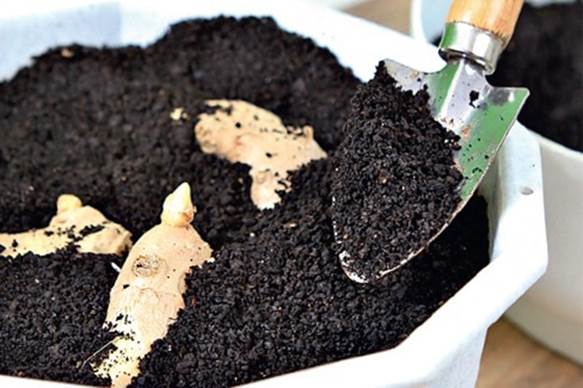
- Slightly deepen the root, while the buds (growth points) should look up (or sideways). Then sprinkle with a layer of moist substrate 2-3 cm thick. In this case, the root should be placed not in the center of the pot, but on the side, so that the sprouts seem to look into the free part of the pot.
However! There is the opposite opinion that while the sprouts will only awaken and grow, they should be in the light. And already when a small shoot appears, they can be dug in.
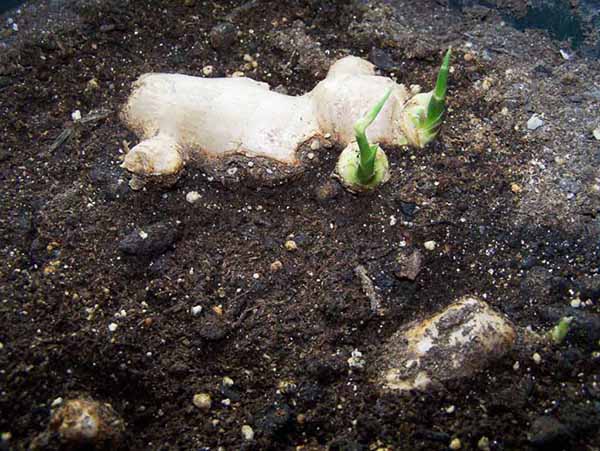
- Water abundantly.
Important! Optionally, you can cover with foil or put on a bag to create greenhouse conditions before the first shoots appear. But watch out for moisture, otherwise root decay may occur.
- Place in a warm and bright place (+20 degrees or slightly higher).
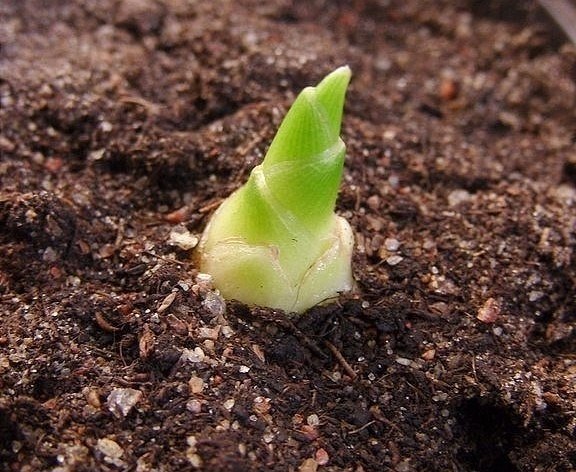
Video: how to plant and grow ginger root at home
How to care for ginger on a windowsill
Taking on the cultivation of any tropical or subtropical plant, the gardener must clearly understand that for the normal development of the plant he needs to create a special microclimate. Not to mention, growing ginger at home requires careful, personalized care.
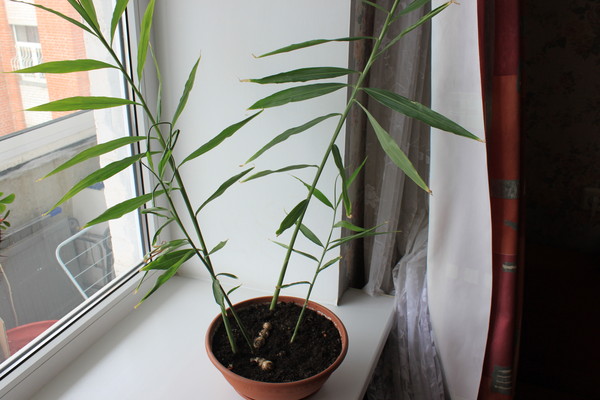
What should be the place for growing: light, temperature and humidity
To grow ginger on the windowsill successfully, in the room should be light, warm and humid.
Ginger grows best in partial shade.... The plant has very delicate leaves, therefore, if you have a southern windowsill, then you should definitely shade it (naturally, in winter and early spring this is not necessary, since there is not enough light anyway). Therefore, it is much better to grow it on the western or eastern windowsill (so that you don't have to shade too much in the summer).
The normal duration of daylight hours is 12-16 hours, so in winter and early spring, be sure to supplement with phytolamps or full-spectrum LED lamps.
The optimum temperature for ginger in spring is + 18 ... + 20 degrees, but in summer - + 28 ... + 32 degrees (the time of the most active growing season). When the plant has a dormant period (late autumn-winter), the temperature should be significantly reduced (should be below +18 degrees). However, if you do not want the plant to "hibernate", then simply do not lower the temperature (so that it is above +18).
Important! Ginger does not like sudden changes in temperature, so in spring and autumn it is better not to take the plant out into the fresh air. But in the summer it is quite convenient to keep it on the street, but not in direct sunlight, otherwise the leaves will simply burn.
Also, the plant needs to create high humidity, therefore, to create a comfortable environment for itshould be sprayed daily with warm water... It is especially important to irrigate vegetative ginger when the air in the room is very dry with heating devices.
However, if the plant is dormant, no additional sprinkling is needed.
Watering
The plant is tropical, which means that it loves moisture very much, but does not tolerate stagnant water.
For normal development ginger needs frequent moderate watering as the soil (top layer) dries up.
Ginger on the windowsill is poured with settled or filtered (soft) water at room temperature.
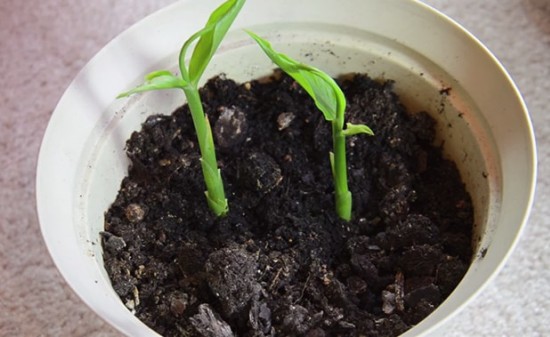
So that air continuously flows to the roots, and the water evaporates easily, each time after moistening the soil must be loosened.
Important! The soil in the pot should never dry out at all. At the same time, the plant cannot be poured: excess moisture entails rotting of the roots.
7-10 days before the expected date of harvest (root digging), any watering is stopped.
Top dressing
During an active growing season, the plant at home can be fed with complex mineral fertilizers, and even better with weak organic solutions (for example, herbal infusion, mullein or bird droppings - everything is diluted and prepared according to the instructions).
Note! If you want to get a big harvest, then feeding is a must. Better yet, make the soil as fertile as possible at once by adding more compost or humus to it.
Naturally, resting ginger is not fertilized.
Transfer to the vegetable garden: open ground or greenhouse
A much more abundant harvest of ginger can be obtained in the soil than in a pot on a windowsill.
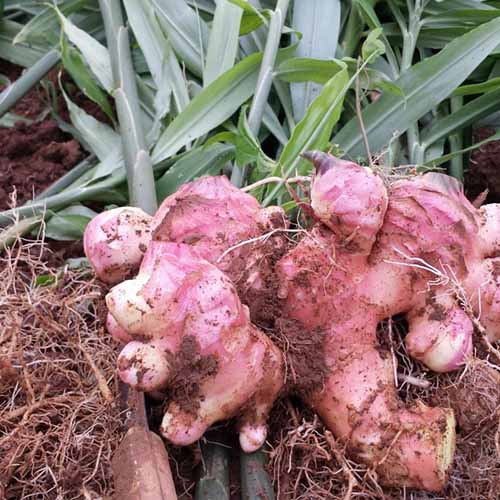
Therefore, you can plant the root in a vegetable garden (ideally in a greenhouse) in late spring or summer, and in the fall (before frost) return it back home to a pot.
The plant is tropical, which means it will not be able to survive the harsh (frosty) winter. Even returnable spring frosts are dangerous for him.
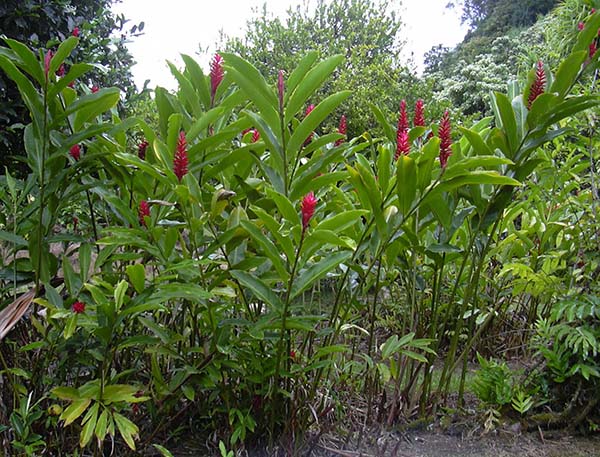
Problems of growing ginger in an apartment: diseases and pests
The tropical plant is naturally endowed with good disease and insect resistance. Even if you successfully grow ginger at home, you can face harmful plant diseases. Most often, a plant grown on a windowsill begins to hurt due to improper care. The most common problems are:
- Leaves turn yellow... This problem occurs due to overflow, direct sunlight. Also, the leaves may turn yellow if the soil in the pot is poorly breathable.
- The plant gradually withers and the leaves dry out.... This condition is caused by an insufficient amount of watering and spraying.
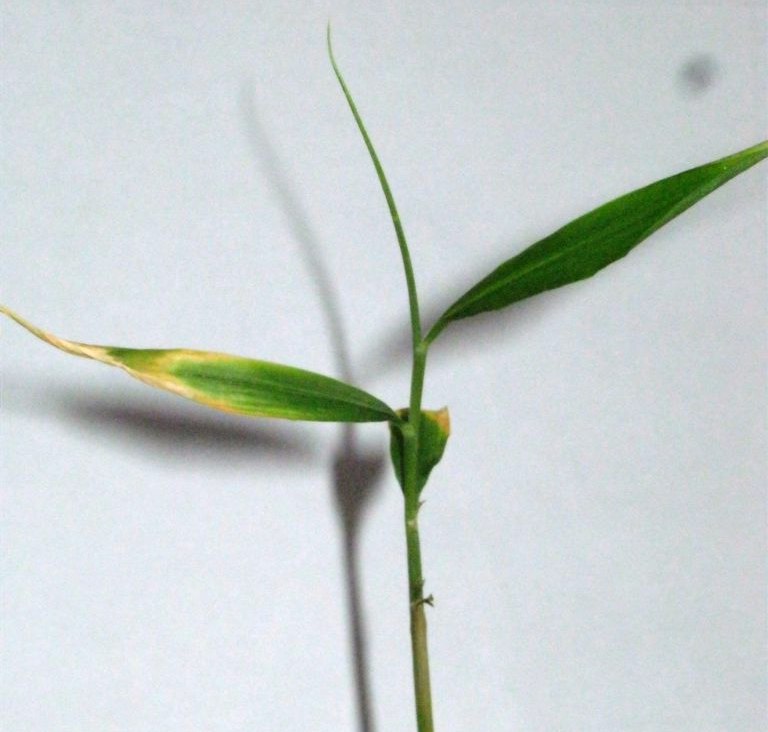
To get rid of this or that disease, you need to identify the cause of the bad condition and correct the care.
Important! If the plant is kept in low humidity conditions for a long time, it will be attacked by a spider mite.
An insect attack is evidenced by the pallor of the aerial part and the appearance of yellow dots, which gradually increase and fill the entire leaf. If you sit back for a long time, the spider mite will suck all the juices from the plant on the windowsill and the plant will die.
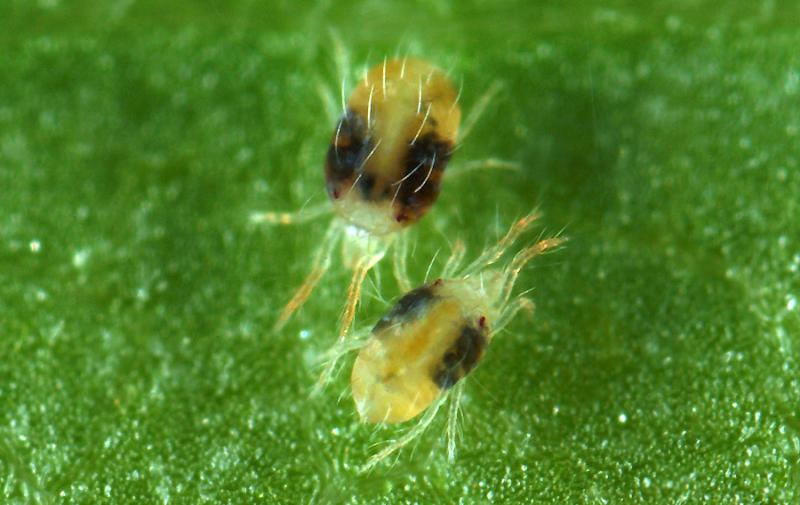
The fight against spider mites is carried out by the following methods:
- Carry out an insecticide treatment (it is advisable to use exactly biologicsphytoverm type). The treatment is carried out until the pest disappears.
- The plant is regularly watered and sprayed... To get rid of the insect, the leaves are washed with water at room temperature, after covering the rhizome with a package. After bathing, the aerial part is wrapped in a transparent bag or film. After a week in a mini-greenhouse, in conditions of high humidity, insects die. However, this method has one drawback: the laid eggs are not destroyed as a result of processing.
Any problem is easier to prevent than to solve. The best prevention of diseases and pests is creating comfortable conditions and proper care.
Terms of germination and harvesting of ginger on the windowsill
When comfortable conditions are created, the first sprouts of home-grown ginger break through to the surface 14-28 days after planting.
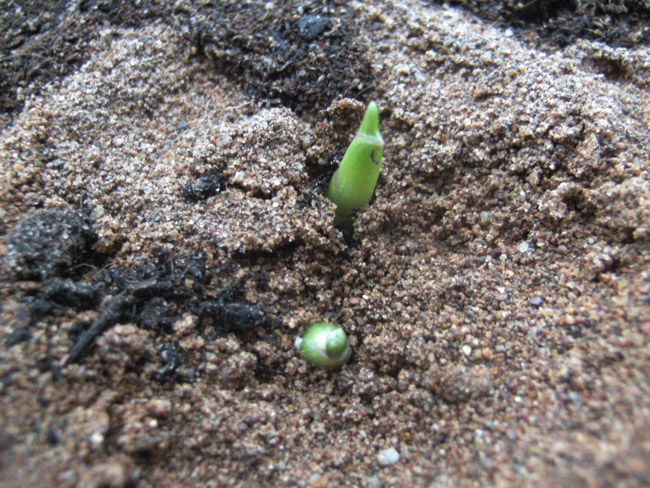
Video: the first shoots of home-grown ginger
Worth knowing! The harvest in 8-10 months will be quite modest (only about 1.5-2 times more than you planted). But rest assured that in terms of nutritional value, homemade ginger will be several times better than any store bought.
As soon as you see that the top and, in general, the tips of the leaves begin to turn yellow and dry, that's it, it's time to harvest - dig up the ginger root. As a rule, about 8-10 months should pass from the moment of planting.
Advice! 7-10 days before the expected date of harvest (root digging), any watering is stopped.
Video: Harvesting Home-Grown Ginger on a Windowsill
Note! It is quite logical that 8-10 months for the development of good tubers will be, frankly, not enough. But a couple of years is probably enough. In addition, you can dig out individual tubers as needed, leaving the mother plant to grow. Of course, even in this case, harvests on an industrial scale should not be expected, but it will be quite enough for seasoning on the family table.
How to store ginger root at home
Ginger can be stored at room temperature quite easily. You can just put it in a cardboard box and it will stay great.
Even a novice gardener who follows all agronomic rules is capable of growing a fragrant, burning, but very useful ginger at home on his windowsill. If you approach the matter wisely, the plant will certainly delight you with bright inflorescences and large juicy roots.
Video: planting and caring for ginger at home


Hello! Thanks for the useful information! I live in Qatar. It's warm here (very) and recently I noticed that the ginger I bought for tea sprouted. He was lying in the kitchen in a basket with onions and garlic, but since it was warm there, he gave off shoots. Now I think to transplant it. I'm not really into living plants, but I like to experiment. I will use your advice. Thanks again!
Thank you, Nadezhda, for a good lesson on growing ginger. It's okay that we are getting old. But we are getting smarter.
I hate ginger, but I can't deny its usefulness).